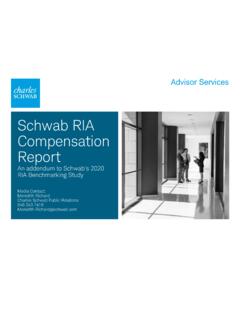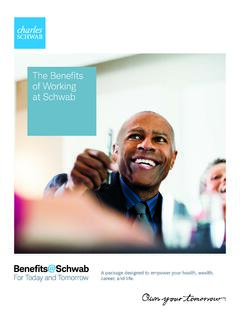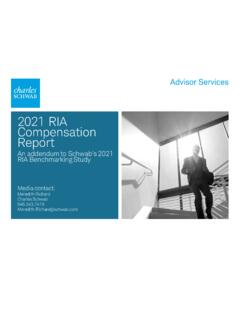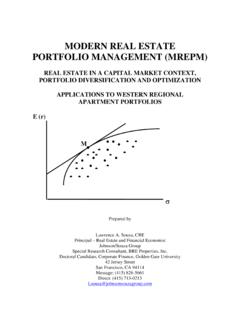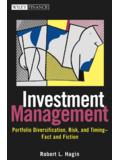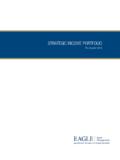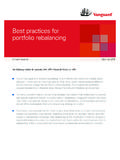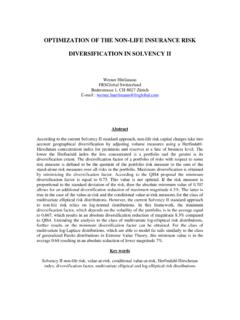Transcription of A Modern Approach to Asset Allocation and …
1 Schwab Center for Financial Research A Modern Approach to Asset Allocation and portfolio construction Anthony B. Davidow, CIMA . Vice President, Alternative Beta and Asset Allocation Strategist Schwab Center for Financial Research James D. Peterson, PhD. Senior Vice President, Chief Investment Officer Charles Schwab Investment Advisory, Inc. Asset Allocation dividing an investment portfolio into different Asset classes, such as large-company stocks, small- company stocks, international stocks, bonds, commodities, cash investments, etc. has been the cornerstone of investment planning for decades. The goal of Asset Allocation is to reduce risk through diversification by having exposure to a variety of investments that perform differently during various market conditions.
2 In recent years, though, we've seen higher correlations or more movement in tandem between Asset classes during periods of market stress. Some are questioning the value of Asset Allocation and the merits of Modern portfolio Theory (MPT), which states that optimal portfolios can be created by considering the relationship between risk and return. It is important to understand that Asset Allocation still helps investor portfolios even during times of market turmoil. In fact, as long as assets aren't moving in perfect lockstep, the longstanding benefits of diversification still hold true. 2. For Schwab Private Client only However, we believe that investors should consider adapting their Asset Allocation strategies to account for higher correlations and new investment choices.
3 The rise of non-traditional Asset classes such as commodities, as well as, expanded stock and bond sub- Asset classes, has given investors additional diversification options. At the same time, mutual funds and exchange traded funds (ETFs). have given individual investors low-cost vehicles to pursue opportunities once confined to institutional investors. Charles Schwab & Co, Inc. has evaluated the Asset Allocation approaches used in the market today. This paper outlines our views about the appropriate Asset mix for different types of investors, and explains the process of constructing a diversified portfolio based on those views.
4 It also highlights the benefit of making controlled tactical shifts within each Asset class to respond to fluctuating market and macroeconomic conditions. 3. For Schwab Private Client only Table of contents Section I. Traditional Asset Allocation 1. More than the sum of the parts 2. Ongoing evolution Section II. New market realities 1. Assets are more correlated 2. Increased external shocks 3. Equity risk dominates traditional Asset Allocation 4. Bond yields are low 5. Expected stock returns are lower Section III. Adapting Asset Allocation to changing times 1. A modernized Asset Allocation for individual investors 2. Which assets should be included?
5 3. Where does each Asset class fit in the portfolio ? a. The role and usage of commodities Section IV. What is the optimal mix? 1. Total return models 2. Income models 3. Tactical shifts Section V. portfolio construction : Putting the pieces into place 1. Evaluating equity choices 2. Customizing allocations 3. Fixed income considerations 4. Evaluating active managers 4. For Schwab Private Client only I: Traditional Asset Allocation Asset Allocation forms the basis of Schwab's investment philosophy. By providing a framework for deploying capital over a mix of investments, Asset Allocation allows investors to diversify their holdings and help mitigate downside risk.
6 This built-in benefit is a well-known feature of Asset Allocation , and it makes intuitive sense . when one Asset class suffers, it pays to not have all your eggs in one basket. But there's another advantage to Asset Allocation that is not understood as clearly: the potential to grow wealth. An appropriately allocated portfolio helps smooth out the ups and downs of the market so investors can enjoy the positive compounding of returns over time. 1.) More than the sum of the parts Consider the following example with two investments: $100 invested in large-company stocks (as represented by the S&P. 500 Index) at the beginning of 1970 would have grown to $7,771 by the end of 2013.
7 $100 invested in commodity markets (as measured by the S&P GSCI . Index) would have grown to $4,829 over the same time period. But if that $100 had been invested in a 50-50 split of both investments, the portfolio would have grown to $9,457 over the same span. This return is 20% more than the stock portfolio alone and almost double the return of the commodity portfolio , while demonstrating lower average risk (see Exhibit 1). While stocks and commodities are both deemed relatively risky investments, combining them helps mitigate the risk of the portfolio . This is due to their relatively low correlation to one another. 5. For Schwab Private Client only Exhibit 1: Risk/ return profile of $100 investment: 1970 2013.
8 $10,000 S&P 500. average annual return $9,457. $9,000 risk $8,000 S&P GSCI $7,771. average annual return $7,000 risk portfolio value $6,000. 50/50 portfolio with annual rebalancing $5,000. average annual return risk $4,829. $4,000. $3,000. $2,000. $1,000. $100. 1970 1975 1980 1985 1990 1995 2000 2005 2010 2013. * Risk is measured as the standard deviation of annual returns Source: Charles Schwab Investment Advisory, Inc. and Morningstar Direct. The example is hypothetical and provided for illustrative purposes only. It is not intended to represent a specific investment product. Dividends and interest are assumed to have been reinvested, and the example does not reflect the effects of fees or expenses.
9 If fees and expenses had been included, returns would have been lower. Past performance is no guarantee of future results. The difference that a diversified portfolio can deliver over the sum of its parts is what Nobel Prize winning economist Harry Markowitz once called the only free lunch in finance. In other words, diversification can deliver benefits over time at no additional cost. This free lunch is made possible by the fact that individual assets typically aren't perfectly correlated. If Asset values do not move in perfect harmony, then a diversified portfolio will have less risk than the weighted average risk of its constituent parts.
10 In fact, a diversified portfolio can often have less risk than its lowest-risk constituent, as it does in the example. The reason lower portfolio risk can lead to higher wealth in the long run is that a portfolio with lower risk generally does not decline as much in a market downturn, so it can recover more quickly than a riskier portfolio that has declined sharply. For example, a portfolio that falls in value by 25% must grow by 33% to recover from its loss. But a portfolio that declines by 10% only needs to grow by 11% to fully recover. 2.) Ongoing evolution Markowitz first introduced the concept of diversification in 1952. Markowitz's work, which served as the foundation for MPT, concluded that an investor could reduce the overall risk of a portfolio by including investments that have low correlations to one 1.



